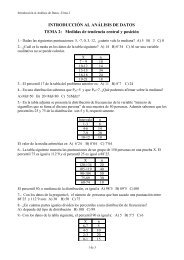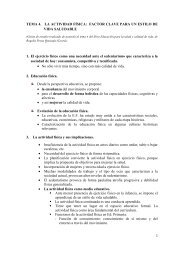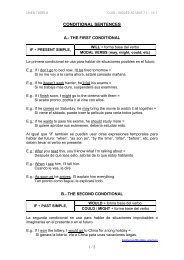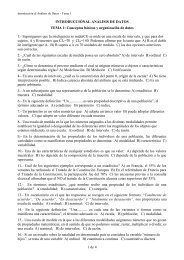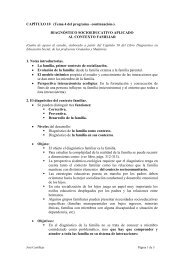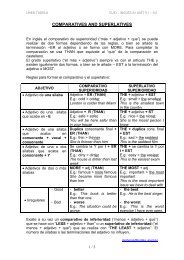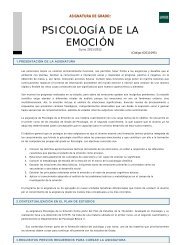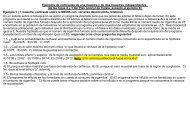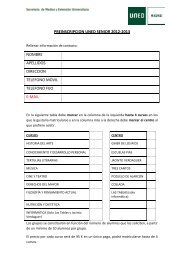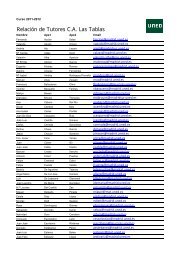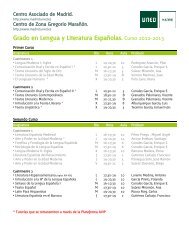PAST SIMPLE
PAST SIMPLE
PAST SIMPLE
- No tags were found...
You also want an ePaper? Increase the reach of your titles
YUMPU automatically turns print PDFs into web optimized ePapers that Google loves.
UNED TUDELA CUID – INGLÉS A1 UNIT 6.1 – 6.2 – 6.3<br />
A2 UNIT 2.1<br />
AFFIRMATIVE<br />
<strong>PAST</strong> <strong>SIMPLE</strong><br />
Para construir el Pasado Simple en afirmativo hay que distinguir dos grupos de<br />
verbos: los verbos regulares y los verbos irregulares.<br />
1.- Verbos regulares<br />
Los verbos que son regulares añaden -ED al infinitivo sin to.<br />
Verbo en infinitivo sin to + ED<br />
E.g.: I cooked the meal for all of them = Cociné la comida para todos ellos.<br />
E.g.: Mary opened the window = Mary abrió la ventana.<br />
Hay que tener en cuentas las reglas de formación a la hora de añadir ED al<br />
verbo:<br />
• Si el verbo acaba en – E, sólo le añadimos la D.<br />
E.g.: dance > danced<br />
• Si el verbo es de una sola sílaba, acabado en vocal + consonante, dobla<br />
esa consonante antes de añadir ED.<br />
E.g.: stop > stopped,<br />
drop > dropped<br />
• Si es de dos sílabas y la última está formada por consonante + vocal +<br />
consonante y es acentuada, también se duplica la consonante.<br />
E.g.: prefer > preferred<br />
E.g.: permit > permitted<br />
E.g.: profit > profited (el acento recae en la primera sílaba)<br />
• Si el verbo acaba el –L, se dobla esta letra antes de añadir ED (Br. Engl.)<br />
E.g.: travel > travelled<br />
E.g.: cancel > cancelled<br />
• Si el verbo acaba en -Y precedido de consonante se cambia la y por i.<br />
Consonante + y = ied<br />
E.g.: study > studied<br />
Pero si la y va precedida de vocal no cambia.<br />
E.g.: play > played<br />
2.- Verbos irregulares<br />
Los verbos irregulares tienen su propia forma propia en el pasado. No forman<br />
el pasado añadiendo ED al verbo.<br />
1 / 2<br />
jlasheras@tudela.uned.es
UNED TUDELA CUID – INGLÉS A1 UNIT 6.1 – 6.2 – 6.3<br />
A2 UNIT 2.1<br />
Infinitive Past Simple Infinitive Past Simple<br />
do did meet met<br />
Have had buy bought<br />
Read read see saw<br />
go went come came<br />
get got make made<br />
NEGATIVE<br />
En la forma negativa e interrogativa, se utiliza el auxiliar DID para los verbos<br />
regulares e irregulares.<br />
Sujeto<br />
DID + not<br />
DIDN’T<br />
Infinitivo sin to<br />
E.g.: They didn’t work together in that company = No trabajaron juntos en esa<br />
compañia<br />
E.g.: They didn’t go to London three years ago = No fueron a Londres hace<br />
tres años.<br />
QUESTIONS<br />
DID Sujeto Infinitivo sin to<br />
Yes, I DID<br />
No, I DIDN’T<br />
E.g.: Did Brian take a picture of the building? = ¿Tomó Brian una foto del<br />
edificio?<br />
E.g.: When did they send the present by post? = ¿Cuándo mandaron el regalo<br />
por correo?<br />
E.g.: Did she bring any refreshments? = ¿Trajo ella algún refresco?<br />
Expresiones Temporales<br />
Con el Past Simple se usan algunas expresiones temporales como AGO y<br />
LAST.<br />
• Periodo de Tiempo + AGO equivale a la construcción castellana de<br />
HACE + Periodo de Tiempo<br />
E:g.: I visited New York 3 months ago = Visité Nueva York hace 3<br />
meses.<br />
• LAST significa pasado, pero en inglés no se usa con artículo.<br />
Eg.: Last week I watched a good film on television = La semana pasada<br />
ví una buena película en la televisión.<br />
2 / 2<br />
jlasheras@tudela.uned.es



